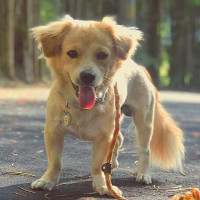Appearance of the Pekehund
|
| Pekehunds resemble larger Dachshunds, with the short muzzle of a Pekingese and feathers around the ears and tail. These small dogs have gentle, inquisitive expressions and reach between 4.5 and 10 kilos and 18 to 25.5 centimeters in height. The type of Dachshund with which the Pekingese is bred will ultimately determine some of the hybrid's characteristics. Obviously, miniature Dachshund parents will produce relatively smaller Pekehunds. In addition, smooth coats, wire coats and long coats will all produce Pekehunds with different coat lengths and textures. However, the most common relative of the Pekehund is the smooth coat. This combination produces a short to medium coat, straight and soft. The coat can be any combination or solid variety of the colors common to Dachshunds and Pekingese. Apart from this, Pekehunds have high, hanging ears, small feline paws and a medium-length, well coated tail. |
Temperament of the Pekehund
|
| Pekingese and Dachshunds are different in many ways, and Pekehunds can inherit any combination of personality traits from each. One characteristic, however, is common to all these breeds: a deep sense of loyalty and attachment to their owners. Pekehunds are very people-oriented and will want to stay with their owners at every possible opportunity. They are true pack animals and will not be happy if left alone for long periods; they do well when “paired” with another pet. As such, owners must make considerable efforts to reduce social anxiety with a consistent schedule, crate training and, of course, lots of love and affirmation. Because Pekehunds also tend to be wary of strangers, socialization between people and other animals is essential to raising a well-adjusted puppy. Generally speaking, Pekehunds tend to be quite intelligent. They need mental stimulation through play and one-to-one interaction, in addition to lots of attention from their families. |
Needs and activities of the Pekehund
|
| Pekehunds need around 30 minutes of activity every day to stay happy and healthy. If they're like their Pekingese parent, they may need less exercise, and if they're like their Doxie parent, they may need more. Either way, Pekehunds will enjoy any activity that lets them spend time with their owners, including walks, trips to the park, games like fetch and learning tricks. They will also enjoy playing with other dogs with whom they are bonded or familiar. Pekehunds may need a jacket in winter, but they do well in all types of weather. What's more, because of their size and activity requirements, these hybrids are well suited to urban and apartment environments. |
Maintenance of the Pekehund
|
| Depending on the type of Dachshund bred, Pekehund maintenance can vary considerably. Pekehunds with stiff or long coats may require weekly brushing and occasional stripping. Pekehunds with shorter coats may require less maintenance, but shed moderately. Whatever the type, feathering around the ears and tail is common. As such, owners may need to trim their Pekehunds coat with clippers or scissors, with some owners even opting for professional grooming. All varieties of Pekehunds should have baths and nail trims on a monthly basis. This hybrid's ears are prone to wax build-up, so owners should check and clean their Pekehunds regularly to avoid infection or discomfort. Finally, like all dogs, Pekehunds should have their teeth brushed daily to avoid dental disease. |









 English (United Kingdom)
English (United Kingdom)